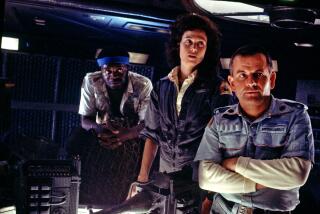Hard to kill
- Share via
For more than a decade, science fiction fanatic Paul W.S. Anderson felt compelled to write and direct “Alien vs. Predator,” bringing together two of his favorite movie titles. It took 20th Century Fox and the film’s many producers almost as long to share his passion.
After several false starts, a studio management shakeup, years of negotiations between feuding producers, a near derailment by a fifth “Alien” movie and a last-minute assist from another studio’s hit slasher film, Anderson finally got his wish, and his resulting “AVP” movie debuts Friday.
“It took a long time to try to figure out how to make it work,” producer John Davis says with understatement.
Combining two of Fox’s best-known science fiction titles, the film seems a natural fit for today’s show business craving for recognizable franchises. The marriage is so obvious, in fact, that an Alien skull made a cameo in 1990’s “Predator 2,” and the Predator and Alien creatures started dueling years ago in popular video games and comic books.
Yet “AVP’s” road to movie theaters has proved as perilous as an abandoned spacecraft, and in an unusually defensive step, Fox decided not to show its nearly $70-million investment to movie critics before its release.
Even without reviews, the movie can deliver plenty to Fox. The film can take advantage of the “Alien” and “Predator” name recognition to launch not only itself but also, if it sells bushels of tickets, potential sequels. New Line Cinema is currently thinking about a follow-up to its 2003 hit “Freddy vs. Jason,” a spin-off from the “Nightmare on Elm Street” and “Friday the 13th” films, and Warner Bros. has toyed with (but recently abandoned) a “Batman vs. Superman” project.
“The advantage we have over a ‘Batman vs. Superman’ or even a ‘Freddy vs. Jason’ is that we are dealing with a species,” Anderson says. “There are any number of Predators, and any number of Aliens, so there can be endless amounts of Alien deaths, and endless amounts of Predator deaths. There’s only one Batman, and one Superman, and Warners is not going to kill one of its franchises off.”
Fox furthermore believes audience interest in “AVP’s” antiheroes will reinvigorate DVD sales for its six previous “Alien” and “Predator” films, and the studio is now releasing a two-disc “collector’s edition” of 1987’s “Predator” (Vivendi Universal Games also has a new “Predator” video game). Finally, a well-received movie might also give fresh energy to “Predator” and “Alien” sequels well into the future.
What sounds like an obvious no-brainer on paper, though, wasn’t so easy when it came to bringing “AVP” to life.
*
Many questions
No matter how skeptical moviegoers might be, studios do try to operate to the best of their abilities, and if you think some of today’s movies are bad, imagine the quality of movies that don’t get made. Such was one of Fox’s dilemmas on “AVP.”
In numerous pitch meetings with the studio and producer Davis, a series of screenwriters struggled to find an effective way of marrying the futuristic Alien creature with the modern-day Predator. There were so many versions that the Writers Guild of America spent four months sorting out the “AVP” screenplay credits (Anderson has sole screenplay credit, with the story by Anderson and Dan O’Bannon & Ronald Shusett).
There were any number of storytelling decisions. Should the movie be set in space, where the Aliens reside? Or back on Earth, where Predators dwell? What time period would be best? Which species would ultimately prevail? Or should the movie be made at all?
Former Fox studio chief Bill Mechanic believed there was still mileage left in the original “Alien” and “Predator” movies, and felt a combination sequel might kill off both. He consequently considered “AVP” a poor idea. “Alien” star Sigourney Weaver said she didn’t want “any part” of a joint movie.
Anderson had different ideas.
He had attended the 1994 Sundance Film Festival with his low-budget drama “Shopping.” While making the rounds in Park City, Utah, Anderson encountered a young Fox studio executive and promptly pitched him his idea for an “Alien vs. Predator” story.
The executive quickly rose up the Fox ladder (Peter Rice now runs the studio’s specialty division, Fox Searchlight), but Anderson’s “AVP” idea went nowhere.
“No one was ever going to give that kind of movie to me to make,” Anderson says. The British director went on to make a number of popular genre films, including “Mortal Kombat,” “Event Horizon” and “Resident Evil,” yet he never stopped thinking about “AVP.”
Meanwhile, circumstances began working in Anderson’s favor. “Alien: Resurrection,” Fox’s fourth film in that series, didn’t do well when it came out in 1997, recording a lower domestic gross than any of the preceding “Alien” movies. “Predator 2,” released in 1990, grossed half of what the 1987 original took in. Mechanic left the studio in 2000.
“The last ‘Alien’ was a bit of a disappointment. Either the movie was not up to snuff or the franchise had run its course,” says Hutch Parker, Fox’s production chief, adding that another “Predator” sequel looked equally unlikely. “As individual franchises, they were likely not to have next chapters.”
Anderson was finally summoned to Fox’s Century City studios, where he pitched Parker his idea, which hadn’t really evolved that much since Sundance. To help tell the story, in which present-day scientists unearth a creature-on-creature battleground deep inside an Antarctica pyramid, Anderson shelled out thousands of dollars of his own money on five giant “AVP” conceptual illustrations by designer Patrick Tatopoulos.
“We really liked his approach, and what he had to say about the movie,” Parker says of Anderson’s presentation. “It felt like a perfect end-of-the summer picture. It all felt right.”
Not that it would be easy.
*
Too many cooks
Even though Fox made all of the earlier “Alien” and “Predator” movies, each film was produced by different people, and not all of those producers were on common ground, or even on speaking terms.
In particular, the two “Predator” movies were produced by Larry Gordon and Joel Silver, and in the years since those films were made, the former colleagues had gone their separate ways and famously feuded. If Davis were to get “AVP” in front of cameras, he had to mend some fences first.
“The hardest part of the movie was getting all of the producers together and then getting rid of all of them,” Davis says. “Because it was just too many cooks in the kitchen. There’s no way this could be done with seven major egos trying to manage the process.” Davis says it took two years to close all of the producer deals.
Then another “AVP” problem loomed. Although “Alien: Resurrection” was a financial disappointment, a fifth “Alien” movie suddenly seemed possible. Ridley Scott, who directed “Alien” in 1979, and James Cameron, who directed 1986’s sequel, “Aliens,” considered joining forces for one more “Alien” production. Fox naturally wanted to see if anything would come of the possible collaboration between two of the most successful filmmakers in Hollywood history. When nothing did, “AVP” was back on track.
Davis and Anderson faced one more snag. According to one account, disputed by Fox, the studio initially didn’t want to spend much more than $40 million on the movie, a budget Anderson and Davis thought would be ruinously cheap. But then New Line’s lightly regarded “Freddy vs. Jason” opened to a stunning first weekend of $36.4 million, and “AVP” had some much-needed momentum. The production budget climbed toward $70 million.
“You often need one last push to get a movie over the top,” Davis says. “I won’t say that [‘Freddy vs. Jason’] was the deciding factor, but any help you can get” is critical.
By shooting the film in Prague and filling the cast and crew with enough Europeans to qualify for incentives and tax credits, Fox was able to save millions.
*
Respect for history
In a Chatsworth warehouse, creature designers Alec Gillis and Tom Woodruff show off full-scale Alien and Predator models, both of which are a bit nicked up, having battled one another so violently.
“Both the characters are icons,” Gillis says. “So we felt a great responsibility to not change them.”
There’s new weaponry for the Predator, more functional articulation for the Alien. But Anderson has tried to make a movie that doesn’t overturn the precedents laid down by the six films before him, and he has memorized every scene in those earlier movies.
“You want to kind of reinvent, but always while paying homage to the original designs,” Anderson says. “I didn’t want ‘Alien vs. Predator’ to put some kind of mythology out there that in some way contradicted [the earlier movies]. It’s a pet peeve of mine when you see franchises over the years that contradict themselves. Because all the hard-core fans say, ‘No!’ And we really care about those things.”
More to Read
Only good movies
Get the Indie Focus newsletter, Mark Olsen's weekly guide to the world of cinema.
You may occasionally receive promotional content from the Los Angeles Times.











